Abstract
In water-scarce regions such as Jordan, accurate tracking of water flows is critical for informed water management. This study applied the Water Accounting Plus (WA+) framework using open-source remote sensing data from the FAO WaPOR portal to develop agricultural water accounting (AWA) for the Amman–Zarqa Basin (AZB) during 2014–2022. Inflows, outflows, and water consumption were quantified using WaPOR and other open datasets. The results showed a strong correlation between WaPOR precipitation (P) and rainfall station data, while comparisons with other remote sensing sources were weaker. WaPOR evapotranspiration (ET) values were generally lower than those from alternative datasets. To improve classification accuracy, a correction of the WaPOR-derived land cover map was performed. The revised map achieved a producer’s accuracy of 15.9% and a user’s accuracy of 86.6% for irrigated areas. Additionally, ET values over irrigated zones were adjusted, resulting in a fivefold improvement in estimates. These corrections significantly enhanced the reliability of key AWA indicators such as basin closure, ET fraction, and managed fraction. The findings demonstrate that the accuracy of P and ET data strongly affects AWA outputs, particularly the estimation of percolation and beneficial water use. Therefore, calibrating remote sensing data is essential to ensure reliable water accounting, especially in agricultural settings where data uncertainty can lead to misleading conclusions. This study recommends the use of open-source datasets such as WaPOR—combined with field validation and calibration—to improve agricultural water resource assessments and support decision making at basin and national levels.
1. Introduction
Water is a vital and finite natural resource that is continuously needed for agriculture, domestic, industrial, and energy sectors. It is considered the driver of economic growth, social improvement, and environmental well-being. Consequently, water has become a focal point for global sustainable development of human societies [1]. Agriculture is a major contributor to global water consumption, with around 70% of total human water consumption attributed to this sector [2]. Within the last 100 years, global water demand has increased sixfold [3], which has increased water demand and requires supply augmentation, particularly in countries like Jordan, where water resources are scarce. The problem of water scarcity in Jordan is attributed to low and irregular rainfall, rapid population growth, and a continuous increase in water demand [4,5,6,7]. Achieving water security in Jordan presents a significant challenge, as the country ranks as the second most water-scarce nation globally—and within the Middle East—when considering its internal per capita share of renewable freshwater resources relative to its gross domestic product (GDP) [8]. According to Jordan’s Ministry of Water and Irrigation (MWI), the availability of renewable freshwater resources stands at an average of 61 m3/capita/year, and it is projected to decline to 35 m3/capita/year by 2040 due to climate change and population growth [6].
Addressing rising demands in water-scarce environments requires comprehensive assessments of water resources and their utilization in space and time [9]. This can be achieved by utilizing open-source data within hydrological models and agricultural water accounting (AWA). In countries with scarce water resources, like Jordan, outputs from AWA are highly important, as these assessments can provide important indicators for water management [6]. At present, the MWI develops the annual national water budgets for Jordan, utilizing ground data and academic experts’ input regarding the water situation in Jordan [10]. These annual budgets serve as the primary source of information for assessing water resources and guiding both short and long-term water resource management [11]. The routinely produced annual water budget reports lack important information on levels of recoverable water, beneficially used water, and footprints of water use. Among the tools that can be used for managing water resources is water accounting (WA), which provides a comprehensive vision for inflows, outflows, and beneficially used fractions of water [12,13]. Batchelor et al. [14] defined WA as the systematic study of the status and trends in water supply, demand, accessibility, and use in specified domains. A critical aspect is that it considers and assesses both the supply and the demand sides of water supply systems. WA’s significance lies in providing accurate information essential for informed debates and providing stakeholders with a basis for identifying the possible fate of water resources under projected water uses in the future.
At the river basin level, WA can play an important role in understanding and managing water resources effectively [12,15,16] by establishing the water balance and quantifying inflows and outflows. In basins with intensive agricultural activities, AWA provides good estimates of recoverable fractions of water that can be reused or developed for reuse, and therefore, it is essential for efficient and sustainable agricultural water management [5]. Applying WA at the river basin level, however, requires the availability of important data on water inflows, outflows, and use. Remote sensing and geographic information systems (GIS) play crucial roles in this process, as they provide valuable spatial, temporal, and spectral data that can be utilized in WA approaches, like Water Accounting Plus, developed by IHE Delft, IWMI, and FAO [11,13,17]. WA+ is a Python-based framework that facilitates water management class-based estimations of the total water depletion (ET) [18]. WA+ assesses water depletions rather than withdrawals, providing a more accurate picture of water consumption and its implications for sustainability. This is especially critical in arid and water-scarce countries like Jordan, where over-abstraction and unsustainable consumption are major concerns [7]. Beyond quantifying water volumes, WA+ explicitly incorporates land use and hydrological interactions [19], making it highly suitable for addressing the spatial complexity of water use at the basin level. The WA+ approach employs open-access remote sensing data to assess water resources at the level of river basins. Among these datasets, the open portal of remote sensing for water and land productivity (WaPOR) (https://data.apps.fao.org/wapor/?lang=en, accessed on 8 July 2025) contributes to AWA by providing data at different spatial and temporal resolutions for WA+ so that water inflows and outflows can be calculated.
The WaPOR portal provides data on 21 parameters, including precipitation and actual ET, at spatial resolutions of 30, 100, and 250 m at a 10-day interval. Based on numerous quality assessments, improvements in the portal and data layers were made, including a beta version, versions 1.0, 1.1, 2.0, 2.1, and 3.0. WaPOR data are made available in different data layers, spatial resolutions, and for different areas in Africa and the Near East. At present, WaPOR data are available at daily, dekadal, monthly, and annual temporal resolutions [11,13] for levels 1, 2, and 3 at spatial resolutions of 250, 100, and 30 m, respectively. Among the WaPOR data, actual evapotranspiration and interception (AETI) is the most important source for water outflows in AWA. AETI-WaPOR is based on a modified version of the ETLook model (ETLook-WaPOR), which was developed to provide open-source ET and other data related to water productivity through the WaPOR portal [13]. ETLook-WaPOR uses the FAO56 Penman–Monteith (PM) to estimate ET adapted to remote sensing input data [20]. The remote sensing-based FAO56PM is preferred over other methods as it can separate ET components into evaporation and transpiration.
The use of WA+ and WaPOR provides important tools and datasets that enable the assessment of sustainability in water supply management by accurately determining the amount of water used in various processes and through the calculation of key performance indicators that show levels of water availability and depletion. In addition, WaPOR datasets enable consistent monitoring of ET, biomass production, and water productivity across different land use types. These features align directly with the MWI priorities, including the need to evaluate agricultural water productivity, manage return flows, and reduce non-beneficial depletions. By implementing WA+, decision makers are empowered to move beyond administrative water budgets toward more spatially explicit and policy-relevant assessments, supporting more informed and sustainable water management strategies [17,21]. The WA+ framework can be integrated into the formulation of a robust national water budget. This framework can enhance the national water budgeting process by providing detailed tracking of water resources, from their generation through various stages of utilization, to final consumption [11]. Moreover, WA+ improves the accuracy of estimates related to water availability, actual consumption, and the remaining resources post-utilization, thereby supporting informed water resource planning. The main objective of this study, therefore, is to develop and assess the utility of open-source remote sensing data for AWA in the Amman–Zarqa basin in terms of the water budget components and outputs during the period 2014–2022. The specific objective of the study is to assess different open-source datasets in comparison to WaPOR data in terms of impact on water inflows and outflows in AWA. The importance of AWA, within the context of the river basin, is the monitoring of water inflows and outflows, as well as its stocks and reserves, so that present and prospective water management strategies are supported by solid information on water resources availability and use.
This study presents a comparative assessment of ET and precipitation estimates from WaPOR against other remote sensing products, official records from the MWI, and climatic data from the Jordan Meteorological Department (JMD). The novelty of the research lies in evaluating the feasibility of using WaPOR as a primary data source for national water accounting in Jordan, offering a potential alternative to the conventional methods currently in use. By integrating and validating multiple data sources, the study highlights the reliability and practical value of WaPOR in supporting consistent and efficient water resource monitoring, especially under data-scarce conditions.
2. Materials and Methods
The study methodology was based on the collection and integration of climatic data, remote sensing data and ground surveys. Climatic data and remote sensing sources other than WaPOR were used to assess WaPOR-derived precipitation and actual ET. Reference ET (ET0) from WaPOR, along with NDVI layers from Landsat 8, were used to derive FAO-56 Penman-Monteith ET, which was then compared with WaPOR’s actual ET. Water use categories were obtained from a detailed land cover map available through the WaPOR portal. Data on groundwater supply to farmers, inflow to KTD, and outflow from the basin were obtained from the MWI. These, along with WaPOR AETI and precipitation data, were input into WA+ sheets to generate the information needed to assess irrigation water supply in AZB and evaluate AWA output. A summary of the methodology is presented in Figure 1.
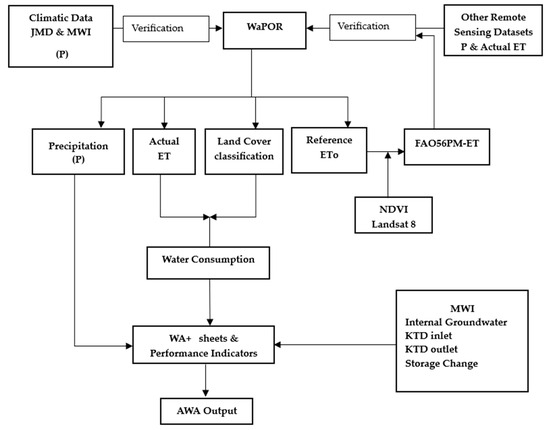
Figure 1.
Flowchart of the study methodology.
2.1. Study Area
The study was carried out in the Amman–Zarqa basin (AZB), which is located in the north of Jordan and covers about 3600 km2 (Figure 2). The basin is significant in terms of its socioeconomic conditions and agricultural activities, as it hosts more than 50% of Jordan’s population [22], 80% of its industry, and 25% of the irrigated area in Jordan [11]. Additionally, the AZB provides water for irrigation in the greater Jordan Valley [22]. The basin includes the northern areas of Amman and Zarqa, in addition to Jerash and the eastern areas of the Balqa Governorate. The mean annual precipitation ranges from 50 mm in the east to more than 500 mm in the northwest near Ajloun and the southwest of Amman. These variations, primarily due to topographic influences, result in an estimated long-term average annual precipitation volume of 782 million cubic meters (MCM) [10]. The climatic conditions in the eastern and southeastern parts of the Basin are classified as arid, with mean annual temperatures oscillating between 7.4 and 24.5 °C. Conversely, the western regions exhibit typical Mediterranean climates, categorized as semiarid in Amman and dry sub-humid in Ajloun, where precipitation levels surpass 560 mm. The western areas are predominantly mountainous, exhibiting cool temperatures during the winter season and mild temperatures in the summer months. Water resources within the basin encompass groundwater aquifers, surface water derived from the Zarqa River, and treated wastewater (TWW); the inflow and outflow are presented in Figure 3.
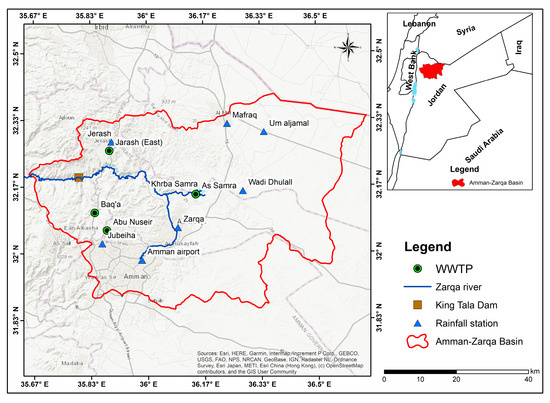
Figure 2.
Amman–Zarqa Basin location map.
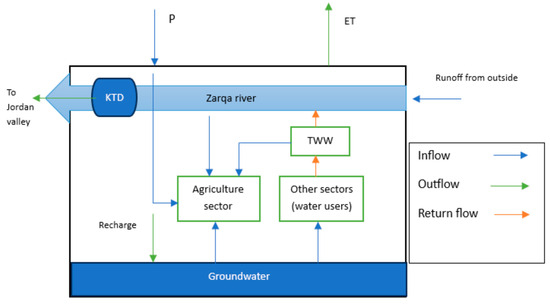
Figure 3.
Components of water budget and agricultural water accounting for AZB. Abbreviations: precipitation (P), evapotranspiration (ET), King Talal Dam (KTD), and treated wastewater (TWW).
Activities of both irrigated and rainfed agriculture and open grazing are taking place in the AZB. In particular, irrigated agriculture is threatening water resources in this basin as groundwater is over-pumped. The total number of recorded wells in this basin is 1043, with a total production rate of 181 MCM/year. This includes 668 agricultural wells, which account for a production rate of 74 MCM/year, representing approximately 40% of the groundwater used for irrigation in Jordan [10]. The primary surface water body in the study area is the Zarqa River, which is utilized as a conduit for TWW (about 100 MCM), predominantly originating from the domestic sector. The basin encompasses two major irrigated zones within the Jordan Highlands: one located to the east of Mafraq City, and the other extending between the As-Samra Wastewater Treatment Plant (WWTP) and the King Talal Dam (KTD). Based on the aforementioned facts, the basin is the most vital region in Jordan, experiencing intense competition for both groundwater and surface water resources across different sectors.
2.2. Data Collection and Processing
The study methodology was based on the collection and integration of climatic records of precipitation, remote sensing data, ground surveys, GIS layers, volumes of water inflows and interbasin transfer, and water pumped to farmers. Daily climatic records of precipitation were obtained from the National Water Information System (NWIS) in MWI [23] and the Jordan Meteorological Department (JMD) for 8 weather stations in the basin (Figure 1). Field visits were conducted to verify land cover maps, irrigation practices, and irrigation uniformity at the farm level.
The annual land cover (LC) maps for the AZB were identified from the WaPOR database level 2, available at a spatial resolution of 100 m from 2014 to 2022. The WaPOR database provides annual land cover maps from 2009 to 2022, relying on the Copernicus land cover product [23]. The cover map was reclassified into the water use categories used in the WA+ system to derive the water use categories needed for applying water accounting.
2.2.1. Calculation of Water Inflows
The precipitation data was used to derive the rainfall inflow required to fill the resource base sheet of WA+. Water inflows to the basin consisted of precipitation and surface runoff. Domestic water supply came from both internal groundwater aquifers and inter-basin transfers, while other sectors (industry, livestock, and tourism) relied on internal groundwater. The volume of precipitation inflow was calculated from recorded rainfall and remote sensing data (Table 1). This included WaPOR precipitation, representing the Climate Hazards Group InfraRed Precipitation with Station (CHIRPS) quasi-global rainfall dataset, along with other remote sensing products, such as the Tropical Rainfall Measurement Mission (TRMM) [24,25] and the Precipitation Estimation from Remotely Sensed Information using Artificial Neural Networks (PERSIANN) [25,26], which provide free global precipitation data with varying spatial and temporal resolutions.

Table 1.
Precipitation datasets.
The annual precipitation data of WaPOR level 1 (5 km resolution) was converted into a vector shape file representing polygons with different rainfall depths. For JMD data, the rainfall volume was calculated by multiplying the rainfall record of each station by the area represented by that station, derived using the nearest neighbor interpolator of Voronoi polygons [13]. The TWW discharge into the river included inflows from four plants in AZB (Figure 2).
TWW generated from non-irrigation water uses represents a substantial water resource that is returned to the Zarqa River, thereby contributing to the surface water outflow toward the Jordan Valley. A limited portion of this flow is allocated for specific agricultural activities along the riverbanks. To estimate TWW inflows to the Zarqa River and ultimately to the KTD, official measurements from MWI at the KTD inlet were utilized. These records account for actual volumes reaching the dam after incorporating upstream transmission losses. Additionally, groundwater (GW) abstraction volumes, which are considered as inflows in the water balance, were obtained from the NWIS of the MWI.
2.2.2. Calculation of Water Outflows
Water outflows from the basin were based on calculating actual ET and residual surface water. For irrigated areas, ET is the net irrigation depth, which would also equal the net irrigation water requirement (NIWR) under non-saline soil and water conditions. Gross irrigation water requirements (GIWR) were obtained by dividing the NIWR by the irrigation efficiency [27] measured for different irrigated farms inside the basin. The amounts of water from WWTP and water pumped from groundwater (GW) were obtained from the NWIS in MWI.
The outflows of ET were obtained from remote-sensing data of WaPOR and five other remote-sensing products (Table 2). The data from WaPOR was mainly used in AWA, while data from other sources was used for comparison with WaPOR data, so that an initial assessment was carried out before its use in AWA. Unlike other remote sensing data of ET, WaPOR included the fluxes of evaporation (E), transpiration (T), and interception (I). These were downloaded for the AZB and were summarized for each water use category derived from the land cover map (LC).

Table 2.
Remote sensing ETa datasets.
The changeable LC was controlling the hydrological response in AZB [22], which influences surface runoff, groundwater recharge, infiltration, and ET. Therefore, to apply AWA for the period 2014–2022, annual LC maps for the AZ basin were needed. These were available from the level 2 data of WaPOR at a 100 m spatial resolution, from 2009 to 2022. The LC was based on the Copernicus land cover product [23]. To derive the water use categories needed for applying water accounting, the LC classes were reclassified into the water use categories used in the WA+ system.
To assess the ET data of WaPOR, the standard method of FAO56 [29] was used to calculate crop evapotranspiration (ETc) as the product of reference ET (ETo) and the crop coefficient (Kc). The difference between ETc and remotely sensed ET is attributed to the use of theoretical Kc values that require detailed information on irrigation practices and crop management. Alternatively, actual Kc values can be obtained from remote sensing data, as described by Al-Bakri et al. [13]. This was carried out using the monthly normalized difference vegetation index (NDVI), which was derived from Landsat 8 images [13]. The annual sum of ETc was calculated for each year, while ETo (mm/month) was obtained from the WaPOR data portal.
2.3. WA+ Analytical Framework
The WA+ framework was developed to use open-access remote sensing-based data for WA at the basin level [17]. The framework combines remote sensing-based data with other available global data and ground measurements to produce standardized WA+ sheets supported by graphs, maps, and tables. The framework of WA+ uses sheets that integrate remote sensing data and simulate water balance, comprehensively assessing water availability and consumption. The most important sheets of WA+ are the resource base and the ET sheets, which can be utilized for the remaining sheets of agricultural services, utilized flow, surface water, and GW. For this study, the resource base sheet was used to provide a comprehensive overview of a basin’s annual water budget and to analyze inflows and outflows. Inflows included precipitation, surface, and groundwater inflows. Outflows included surface and groundwater outflows and actual ET. The second sheet in the WA+ framework was the ET sheet, which was used to estimate water outflows in the form of ET across the various water use categories derived from the LC map. The water use within WA+ included four different water management classes for ET and T [13,17,25], providing an overview landscape of water consumption. Within this sheet, ET components include interception, evaporation, and transpiration. The values of ET and T were evaluated for the non-manageable, manageable, and managed types of water and land use (WALU). This was carried out to calculate the percentage of each component of ET according to WALU, which would allow the identification of the portions of beneficial and non-beneficially used water. This information would not be found in the traditional water budget. Furthermore, the outputs derived from both sheets were utilized to compute the quantitative performance indicators (PIs) related to water availability and utilization at the basin level (Table 3).

Table 3.
The key performance indicators of WA + resource base and ET sheets.
3. Results
3.1. Land Cover and Water Use Categories
The WaPOR database provided yearly land cover maps (LCC) for AZB for the period 2014–2022 based on the Copernicus land cover product [22]. Figure 4b presents the 2022 land cover map derived from the WaPOR database. The map distinguishes thirteen major land cover classes, including four specific categories for tree cover. The dominant land cover types in the basin are bare/sparse vegetation, grassland, and rainfed cropland, collectively accounting for approximately 85% of the total basin area. These are followed by urban areas, shrublands, and irrigated croplands. Over the study period, WaPOR data indicated no substantial changes in the extent of natural land cover classes. The land cover area of cropland classes varied between 2014 and 2022; the total area of rainfed cropland and irrigated cropland increased, while that of fallow cropland decreased (Figure 4a). The total change in cropland area is due to the growing area of irrigated cropland in the AZB. The LC classes were reclassified into four major water use categories used in the WA+ system that differ in terms of water management: protected land use (CLU), utilized land use (ULU), managed land use (MLU), and managed water use (MWU). In 2022, the basin’s land cover distribution was composed of 70% ULU, 20% MLU, and 10% MWU, with irrigated areas accounting for only 2.1% of the total.
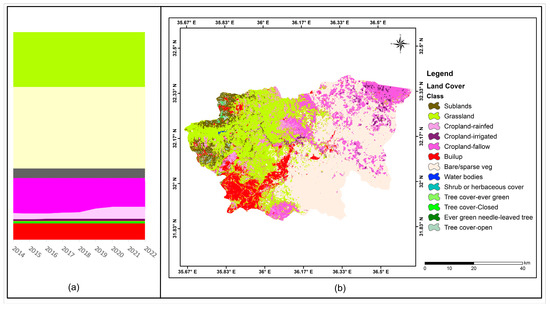
Figure 4.
Land cover map of AZB demonstrating its temporal variation during 2014–2022 (a) and spatial variation in 2022 (b).
These findings suggest that the WaPOR land cover classification underestimates irrigated areas, a finding consistent with earlier studies [11]. Shammout et al. [22] reported an irrigated area for AZB of approximately 180 km2 in 2017, whereas WaPOR in our analysis estimated 70.8 km2 for the same year. This discrepancy highlighted a significant underestimation of irrigated land.
The map of land cover for WaPOR was assessed using a reference map that was prepared using open-source data from World Viewer [30] with modification for irrigated areas, which were mapped using the method outlined by Al-Bakri et al. [5] and onscreen digitizing of the forest area. A confusion matrix [31] was generated to derive user and producer accuracy using the whole image data (Table 4). Generally, the WaPOR landcover map has high user accuracy. However, the producer’s accuracy and the Kappa values showed lower accuracy due to mixing between irrigated and rainfed areas. As a result, the WaPOR LC map underestimated irrigated areas, which could impact the results in the ET sheet of WA+.

Table 4.
Confusion matrix and accuracy assessment of the reclassified WaPOR LC map for the year 2022.
3.2. Water Inflows
Volumes of water inflows to AZB from rainfall based on WaPOR data ranged from 593 to 912 MCM, while calculated rainfall volumes from rain stations ranged from 622 to 1165 MCM. The precipitation volume from other remote sensing sources is shown in Figure 5, in addition to data from water budget and station records. Daily station records were aggregated to yearly values multiplied by the area around each station and compared with the corresponding WaPOR data. Annual rainfall biases relative to WaPOR are shown in Figure 6. The results indicate that JMD generally reported slightly higher rainfall than WaPOR, particularly during wetter years such as 2015 and 2020, suggesting a modest underestimation by WaPOR during high-intensity events. PERSIANN exhibited the highest interannual variability, with notable overestimations in 2018 and significant underestimations in 2020. TRMM consistently underestimated rainfall compared to WaPOR, while MWI estimates were more closely aligned, though still showed some interannual fluctuations. Statistical evaluation further supported these observations.
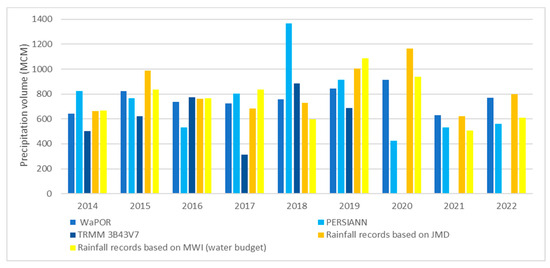
Figure 5.
Comparison of precipitation volumes calculated from remote sensing data and rainfall records.
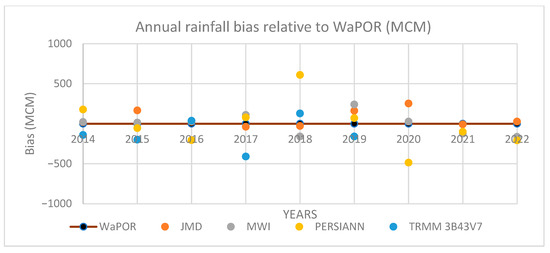
Figure 6.
Annual rainfall bias relative to WaPOR (MCM).
Rainfall comparisons revealed a strong agreement between WaPOR and JMD records, with a Pearson correlation coefficient of r = 0.95 and a 95% confidence interval of [0.89, 0.99], as estimated using the block-bootstrap method. MAE and RMSE values were also lowest for the JMD dataset (MAE = 21.4 MCM, RMSE = 28.6 MCM), confirming its closer alignment with WaPOR. MWI estimates demonstrated moderate correlation (r = 0.74, CI = [0.18, 0.96]), with slightly higher error metrics (MAE = 38.7 MCM, RMSE = 45.2 MCM). In contrast, satellite-based products such as PERSIANN and TRMM showed weaker and more inconsistent correlations with WaPOR rainfall (Table 5), accompanied by larger error magnitudes, particularly for PERSIANN (MAE = 61.3 MCM, RMSE = 78.4 MCM), highlighting its limited reliability at the basin scale.

Table 5.
Correlation analysis of annual WaPOR−P compared to other datasets in the AZB.
Other sources of inflows to the basin included an average of 167.4 MCM of water pumped from GW and the annual flow of the Zarqa River, recorded at the KTD entrance at an average of 138.6 MCM. These data were obtained from the NWIS. The amount of surface water from the basin’s headwaters in Syria was minor and can be negligible, ranging from 1 to 2 MCM over the study period [11].
3.3. Water Outflows
The WaPOR AETI layer estimates the total ET, including interception. Figure 7 shows the spatial variability of actual ET (ETa) in the AZB. The highest ETa value is observed in water bodies (KTD) and irrigated areas, while the vast bare land has the lowest value. It can be seen in this map that the agricultural development along the Zarqa River and KTD has relatively high ETa. AETI from WaPOR data showed that utilized land use constituted 63% on average of the total AETI outflows, followed by modified land use, with 20%. The lowest was managed water use, with 10% on average, and the irrigated areas contributed to only 7.0%. A summary of water outflows is presented in Table 6.
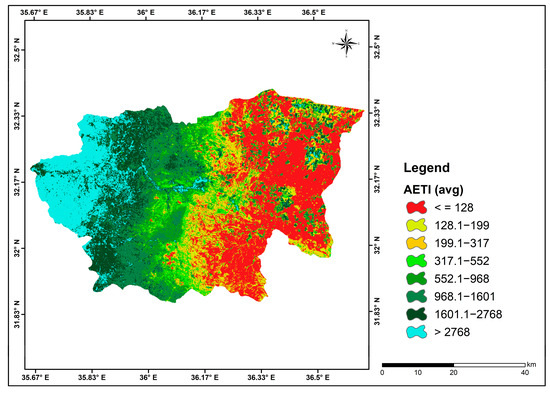
Figure 7.
Spatial variation of WaPOR AETI in AZB based on average annual data from 2014 to 2022 hydrological years.

Table 6.
A summary of water outflows in the AZB in (MCM).
Figure 8 compares the annual ETa volume derived from six remote sensing datasets over the AZB, alongside FAO56 PM and the national water budget. The results from the six remote sensing datasets, when compared to WaPOR data, indicated that the average annual WaPOR AETI was approximately 528 MCM, which is lower than the average of the other datasets (572–692 MCM). This suggests that WaPOR may underestimate ET, with the highest correlation for the WaPOR dataset found with ET MODIS 500m. Conversely, WaPOR AETI was compared with evaporation estimates reported in the national water budgets from 2014 to 2022. In these budgets, the reported evaporation exceeded WaPOR’s data for all years, except in 2021, when reported evaporation fell short of WaPOR’s data by −38 MCM.
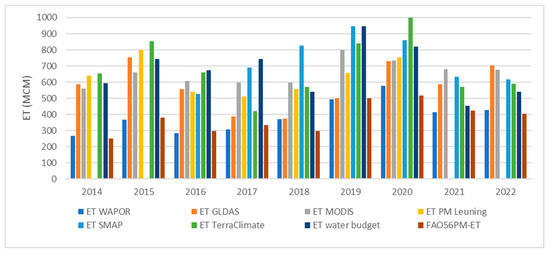
Figure 8.
Comparison of multiple ET remote sensing products in the AZB.
To assess the consistency of ET estimates from various datasets with WaPOR data, Pearson correlation coefficients were calculated and supplemented by block-bootstrap resampling to generate 95% confidence intervals (Table 7), accounting for potential temporal autocorrelation. Among all sources, FAO56 PM showed the strongest agreement with WaPOR ET, with a high correlation coefficient (r = 0.94; CI = [0.71, 0.98]), and the lowest error values (MAE = 26.8 MCM; RMSE = 35.2 MCM), confirming both strong association and accuracy in magnitude. MODIS 500m ET also exhibited a strong correlation (r = 0.87; CI = [0.54, 0.95]) but showed larger deviations in absolute terms (MAE = 267.6 MCM; RMSE = 272.0 MCM), possibly due to differences in spatial resolution and model structure. Weaker correlations were observed for ET GLDAS and the water budget estimates, both of which also presented high RMSE values. It is important to note that the national water budget may not adequately capture the spatial and temporal heterogeneity of land use and irrigation practices, which can significantly influence ET rates.

Table 7.
Correlation analysis of annual WaPOR-ET compared to other datasets in the AZB.
Overall, these results highlight that while multiple ET datasets show a moderate to strong correlation with WaPOR, substantial variability exists in their magnitude of deviation, with only the FAO56 PM method providing both high consistency and low error. This underscores the importance of validating remote sensing products against multiple references before use in operational WA frameworks.
To address the potential underestimation of ET by WaPOR, as a previous study showed at the basin level [11], a bias correction was applied based on an independent reference dataset. Al-Bakri et al. [27] estimated the actual ETc in irrigated areas of the AZB for the year 2014 at 115.2 MCM, whereas WaPOR data for the same year and comparable irrigated extent yielded only 23.3 MCM. This discrepancy corresponds to a bias correction factor of 4.9, indicating that WaPOR underestimates ET for irrigated areas by a factor of nearly five. Accordingly, this factor was applied exclusively to WaPOR-derived ET for irrigated lands, which constitute the most water-consumptive land use in the basin.
Although the reference dataset pertains to 2014, the correction factor was uniformly applied to the entire analysis period (2014–2022). This is justified by the relative stability of irrigated agriculture over the study years. For example, Shammout et al. [22] reported only a 0.17% increase in irrigated area between 2011 and 2017, and Al-Bakri et al. [13] confirmed minimal changes in land use from 2017 to 2019. These findings support the assumption of limited interannual variability in irrigated area and associated water use, thereby validating the temporal applicability of the correction factor throughout the study period.
The variation in the basin’s average ETa follows a similar trend to precipitation. Bastiaanssen et al. [32] mentioned that areas that satisfy precipitation > ETa are considered water-generating regions, while those that fulfill ETa > precipitation are net water consumers, which means that the AZ basin has net water generated from rainfall and that the excess precipitation that is not consumed via ET can generate surface runoff, drainage, groundwater recharge, seepage, and baseflow. In the AZ basin, excess water can only exit the basin through groundwater outflow, inter-basin transfers, which are no longer accessible in the basin, or recharge deep groundwater storage, and is considered recoverable.
Calculations of ETc using Kc and NDVI values for irrigated farms revealed that the NIWR and GIWR for irrigated areas in the AZB ranged from 17.5 to 36.2 MCM and 25.0 to 51.8 MCM, respectively. Irrigation efficiency was set at 70%, based on actual field evaluations conducted in six farms. Efficiency was calculated using field-based measurements of applied water in farms, and the reported value reflects the average across these sites. The total amounts delivered to these areas using WaPOR ranged from 19.5 to 37.6 MCM, with an obvious gap between supply and demand.
3.4. AWA Outputs
3.4.1. Resource Base Sheet
The WA+ resource base sheet (Figure 9) provides information on water volume inflow, outflow, and its current utilization per different land cover categories. The resource base sheets, summarizing the AZ basin’s water budgets for the 2014 to 2022 hydrological years, are presented in Table 8. Water inflows into the AZ basin ranged from 928 MCM for the year 2021 to 1228 MCM for the year 2020. Precipitation accounted for 70–75% of total inflows, except in 2014 and 2021, when it decreased to 69% and 67% of total inflows, respectively. The main river stem inflow (inlet to KTD) ranged from 115 MCM in 2017 to 156 MCM in 2020, with 138 MCM on average. Utilized GW ranged from 160 to 177 MCM, which accounted for 12% of the average total inflow. Landscape water consumption increased from 219 MCM in 2014 to 499 MCM in 2020. This indicates that ET demand was the highest in 2020. Following the bias correction of ET for irrigated lands, the corresponding values in the sheet were adjusted to reflect the five-fold increase in ET from these areas. This modification was necessary to capture the impact of elevated ET on water outflows, particularly given the high water consumption associated with irrigated agriculture. Consequently, the WA+ resource base sheet was recalculated (Figure 10). The results revealed a substantial reduction in estimated outflows, with total outflow decreasing by a factor of 2.2. This highlights the sensitivity of WA outputs to ET accuracy, especially in regions where irrigated agriculture constitutes a major component of water demand.
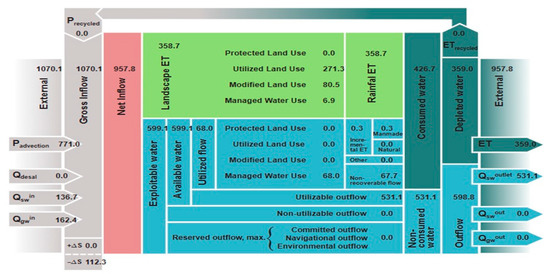
Figure 9.
WA resource base sheet (MCM) of AZB for the 2022 hydrological year.

Table 8.
Summary of resource base sheet results for the AZB during 2014–2022 in MCM.
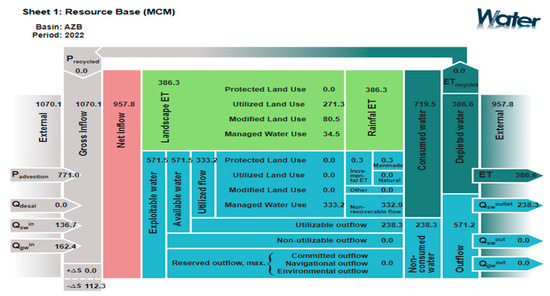
Figure 10.
WA+ resource base sheet (MCM) after correction of ET for irrigated lands of AZB for the 2022 hydrological year.
In terms of ET fractions, grassland, shrubland, and bare land (ULU) have the highest water consumption, accounting for about 60% and 17.5% of rainfed areas (MLU), respectively, and 16% from MWU, with irrigated agriculture accounting for only 7% (Figure 11). The findings reveal that irrigation did not constitute the primary water consumer in the AZB. Exploitable water within the basin ranged from 412 MCM in 2021 to 729 MCM in 2016. Exploitable water includes two components: (i) managed water consumption (utilized flow), which includes water consumed in agriculture (irrigation water), the water body (KTD), and the urban area, and (ii) non-consumed water within the basin. Managed water consumption rose from 47 MCM in 2016 to 79 MCM in 2020 but decreased slightly to 64.9 MCM in 2021. The increase in managed water consumption reflects growing water demands from various users in the basin.
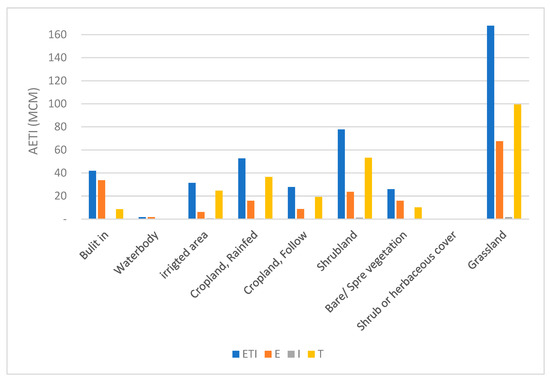
Figure 11.
WaPOR-AETI and its components for the different land and water use categories in the AZB during 2022.
The non-consumed water is equivalent to basin outflows. Outflow through KTD is accounted for in the sheet as storage in the sink, so the non-consumed water ranged from 347 MCM in 2021 to 682 MCM in 2016, a reduction in 2021 attributed to decreased precipitation, which accounted for 44 to 70% of net flow. The total water consumption in the basin is represented by AETI, which is further divided into landscape ET (i.e., ET from rainfall) and the incremental ET associated with managed water use. This distinction helps determine whether ET is fully met by precipitation alone or if additional water sources (e.g., irrigation or other supply) are required. Consumed water increased from 266.5 MCM in 2014 to 578 MCM in 2020, before decreasing slightly to 415 MCM in 2021. The increased water consumption within the basin indicated a growth in water demands.
The performance indicators (PIs) for AZB are summarized in Table 9. The results indicate that not all water inflows were fully utilized, with the consumed fraction averaging only 36% over the study period—a notably low value, primarily attributed to the underestimation of ET by the WaPOR dataset. Following the ET correction, the consumed fraction increased from 36.2% to 67.2%, which aligns closely with the findings of the authors of [11,13], who reported ET fractions of 67% and 64%, respectively. According to Al-Bakri et al. [13], the results of AWA in the Northern Jordan Valley (NJV) revealed that most of the irrigation water inflows were consumed as ET, with approximately 66% attributed to irrigated agriculture and 7% to rainfed areas. This highlights the dominant role of irrigation as the main water consumer in the basin. The unconsumed water contributed to both surface and groundwater reserves. Basin closure ranged from 6.5% to 15.8%, indicating that only a limited portion of the available water resources was consumed within the basin, while the majority either left the basin as outflow or remained unutilized. This suggests that the basin is far from being hydrologically closed. The managed water fraction increased from 13.6% to 17.4% during the 2017–2021 period.

Table 9.
Performance indicators for the AZB during 2014–2022 in MCM.
3.4.2. Evapotranspiration Sheet
The purpose of the ET sheet (Figure 12) was to quantify water consumption for all land use classes throughout the basin and provide information on whether water was consumed beneficially or non-beneficially. The ET sheet breakdown includes evaporation, transpiration, and interception from different water management classes and defines which portion of ET is beneficial and which is non-beneficial, as shown in Table 10. A significant portion of water (56.3% on average) is utilized beneficially, with 55% of ET being T on average.
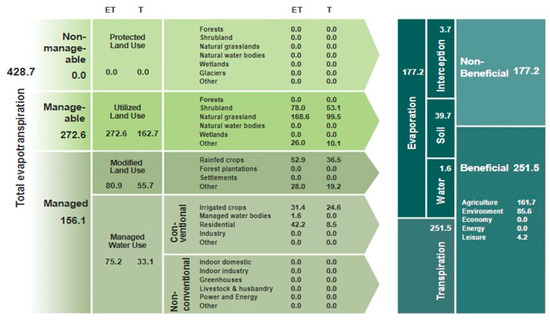
Figure 12.
WA+ ET sheet (MCM) of AZB for the 2022 hydrological year.

Table 10.
Summary of ET sheet results for the AZB during 2014–2022 in MCM.
The ET sheet shows that the most beneficial use of water in the AZB is related to agriculture, followed by environmental use. The shares of manageable and managed water consumption to the total water consumption ranged from 156 to 362 MCM and from 101 to 215 MCM, respectively. Manageable land use classes have consumed more water than managed land use classes in the basin; there were no non-manageable shares in the basin. Following the correction, the ET sheet was updated (Figure 13) to account for the increased ET in irrigated areas. As a result, the water consumption attributed to the managed land use class increased by a factor of 1.8 relative to the manageable land use class. Additionally, the beneficial fraction improved, rising from 59% to 63%, reflecting a higher proportion of water use contributing to productive outcomes.
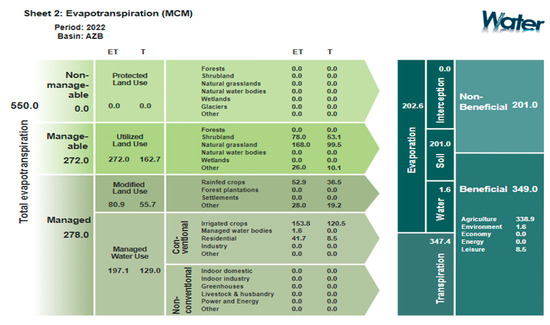
Figure 13.
WA+ ET sheet (MCM) after correction of ET for irrigated lands in AZB for the 2022 hydrological year.
Table 9 summarizes the PI of the ET sheet for the AZ basin. The T, agricultural ET, and irrigated ET fractions averaged 56.3, 36.7, and 7.0%, respectively. The results show that there was a small proportion of irrigated areas in the basin. Al-Bakri et al. [13] reported that over 80% of ET was beneficially used in the Northern Jordan Valley, suggesting efficient water use under deficit irrigation practices, compared to 59% in the AZB.
4. Discussion
4.1. WaPOR Data Assessment
The results of this study demonstrated that the correlations between WaPOR precipitation annual data and JMD rainfall records were strong and statistically significant, aligning with findings reported in previous studies [11,13,33]. The findings indicated that the employment of WaPOR precipitation data resulted in an underestimation of rainfall across the majority of evaluated years. Prior research has demonstrated that utilizing WaPOR data for precipitation analysis over expansive geographical regions may amplify the uncertainty associated with hydrological model outputs [13,34]. This phenomenon is not exclusive to WaPOR precipitation data; similar discrepancies in rainfall underestimations have also been documented for other remotely sensed precipitation datasets [35]. Karimi et al. [36] noted that a frequent challenge in evaluating the accuracy of satellite-based rainfall datasets lies in the spatial scale mismatch between rain gauge measurements and the area-averaged values represented by individual satellite pixels. These findings underscore the importance of calibrating precipitation data from remote sensing to ensure their suitability for various uses, including AWA. As an important variable in the water budget, the annual precipitation volumes from WaPOR datasets were compared with rainfall records from JMD and water budget reports from NWIS for the period 2014–2022. The comparison of rainfall estimates revealed that WaPOR data generally showed good agreement with JMD records, particularly in terms of interannual trends and total rainfall, with a strong correlation (r = 0.95) and the lowest error values. This indicates that WaPOR can reasonably reflect observed rainfall patterns, especially during average years. However, WaPOR tended to underestimate rainfall during wet years, such as 2015 and 2020. NWIS data were moderately aligned with WaPOR. These differences can be attributed to factors such as MWI’s methodology for deriving precipitation volume, which depends on the weighted average rainfall depth from 23 stations in the basin, versus WaPOR’s finer resolution. Ta’ani [37] mentioned that the data from meteorological stations used to calculate the hydrological balance in the NWIS and reporting system are often insufficient in terms of spatial and temporal coverage. Furthermore, Amdar et al. [11] argued that the hydrological balance is reported at the basin scale, while water use is documented at an administrative scale. This inconsistency in the spatial scale complicates water assessments at the basin scale. Consequently, using WaPOR precipitation data is regarded as a judicious option for Jordan, where water budget components heavily depend on long-term averages and expert judgment. However, the results reveal a poor correlation between WaPOR and other remote sensing data. PERSIANN showed the most variability and largest errors, limiting its reliability for basin-scale analysis, and TRMM consistently underestimated rainfall. This variation can be attributed to the differences in satellite sources and the methods used to derive precipitation from remote sensing data. WaPOR precipitation data is derived from CHIRPS, a remotely sensed product that incorporates bias correction techniques. In contrast, PERSIANN estimates rainfall using artificial neural networks applied to thermal infrared satellite imagery [38], while TRMM combines satellite observations with ground-based rain gauge measurements. Singh et al. [26] evaluated the PERSIANN and CHIRPS precipitation data and found that CHIRPS was the best precipitation product based on significant statistical relations with rainfall records.
Karimi et al. [36] noted that one of the main limitations in evaluating the reliability of remotely sensed ET products lies in the lack of proper validation of their spatial layers. Ground-based ET flux measurements, often considered the most reliable, are limited by high costs and logistical challenges associated with installing and maintaining equipment across diverse and often remote areas within a river basin. Despite ongoing technological advances, affordable and scalable methods for ET measurement remain limited. Consequently, many studies utilizing spatial ET datasets have not conducted prior calibration and instead rely on post-analysis validation to assess the accuracy of satellite-derived ET estimates. In this study, WaPOR ET values were found to be significantly underestimated by approximately 50% when compared to five other remotely sensed ET products. This underestimation is likely attributed to differences in spatial resolution among datasets, which affect the input data and algorithms used in ET estimation. Al-Bakri et al. [13] also emphasized that the spatial resolution introduces greater uncertainty in ET mapping than land cover classification accuracy, highlighting the importance of considering the resolution when selecting ET products. Furthermore, the dominance of bare soil in the AZB, characterized by NDVI values below 0.1, may contribute to lower ET estimates from WaPOR. Since the WaPOR methodology relies heavily on NDVI as a primary input, it may underrepresent ET in areas with sparse vegetation. In contrast, other remote sensing approaches that utilize surface temperature may yield higher and potentially more accurate ET values in such environments.
The findings of this study demonstrate that uncorrected WaPOR ET data can lead to a significant overestimation of recoverable water volumes. Specifically, applying a correction factor for irrigated areas resulted in a reduction in estimated recoverable water by a factor of 2.2. This reinforces the need for incorporating ET bias correction into operational applications of the WA+ framework. Moreover, selecting the appropriate WaPOR data level (e.g., annual, monthly, or daily) is crucial, as it directly influences AWA outputs and overall water accounting accuracy. While the current analysis relied on WaPOR V2 -L2 products due to their availability and temporal consistency from 2014 to 2022, recent developments in the WaPOR platform, specifically the release of Version 3 tiles, may offer improved accuracy in ET estimation, particularly in regions dominated by bare or sparsely vegetated land. WaPOR V3 integrates updated biophysical algorithms and improved land surface inputs, which could help address some of the limitations observed in WaPOR V2-L2 data. Therefore, future work could focus on exploring and comparing the performance of WaPOR V3 in semi-arid environments like the AZB to assess its suitability for basin-scale water accounting.
A strong correlation was observed between ET estimates from FAO56-PM and WaPOR, which can be attributed to their shared reliance on NDVI-derived inputs. The reported evaporation in the water budget surpassed WaPOR’s ET data. Therefore, the NWIS and water reporting should consider the potential influence of LU and landscape characteristics when analyzing evaporation and calculating outflows. Within the context of the study area and Jordan water budgeting approach, the use of precipitation as the only measured parameter [37] is insufficient and non-informative for water management purposes. This is mainly due to the lack of runoff and evaporation measurements; under such conditions, the contribution of WaPOR would be highly valuable and would provide an important complementary data source.
4.2. Remote Sensing Data and Water Accounting
Remote sensing provides a valuable source of data for water accounting (WA), especially when long-term field measurements are unavailable or when used to complement existing field data [11,13]. Tiruye [39] also mentioned that the reasons for the requirement of remote sensing-based data relate to data scarcity, cost-effectiveness, and the needed accuracy. Shilpakar et al. [12] demonstrated that remote sensing data, even with minimal ground-based input, can reliably generate the key components required for water accounting and support the effective assessment of water resource conditions. ET and rainfall are key components of the water balance, and remote sensing data from WaPOR is a useful tool that saves time and effort. However, the accuracy of remote sensing data directly influences the reliability of AWA outputs. In the AZB, the findings indicate that WaPOR precipitation data is a suitable input for AWA, as it aligns well with rainfall records from the JMD, and performs better than the NWIS water budget approach. This supports the broader applicability of WaPOR and other satellite-derived products in water resource planning, flood management, and agricultural drought monitoring and assessment [40,41]. Conversely, utilizing ET data from WaPOR has been found in this study to underestimate by half compared to other datasets, leading to the overestimation of outflows that could have been considered return flows and potential sources of water. The initial WaPOR-based assessment indicated that only 7% of basin-scale ET originated from irrigated agriculture, which appeared inconsistent with documented cases of groundwater over-abstraction. Upon further evaluation, this discrepancy was attributed to the underestimation of ET in irrigated areas and potential land cover misclassification. To address this, a correction factor was applied to WaPOR ET values using reference ETc data. The revised analysis led to a substantial increase in the estimated ET from irrigated lands, rising from 7% to 28% of the total basin ET. Correspondingly, the consumed fraction increased from 39.9% to 67.2%, basin closure increased from 10% to 58%, and the WA+ performance indicators more accurately reflected the basin’s stressed water conditions. In contrast to the water budget approach used by MWI, remote sensing-based WA provides more detailed information on water inflows and outflows across all land cover classes in the basin, highlights the proportions of manageable and non-manageable water fractions, and differentiates ET into beneficial and non-beneficial fractions. These results highlight how water accounting outputs are sensitive to input data accuracy and stress the need to include bias-correction methods when using satellite-derived ET for operational assessments.
The variability in rainfall directly impacts water availability, and surplus rainfall does not contribute to surface runoff. Instead, it must be discharged elsewhere, with groundwater recharge being the only potential outlet, as reported by FAO and IHE Delft [42]. Al-Bakri et al. [13] noted that the proportion of water percolating underground is typically not measured and is viewed as a loss rather than a significant source of groundwater recharge that could be recovered. Investigating the pathways and processes involved in the movement of excess rainfall into underground basins is crucial. Understanding these mechanisms can aid in the effective and sustainable management of water resources. The available water in the AZ basin ranged from 577 to 807 MCM, representing a high volume that aligns with Amdar et al. [11], who suggested that the available water quantified using the WA+ approach may be overestimated. Groundwater inflows and outflows play a fundamental role in evaluating overall water availability, particularly in light of the fact that the agricultural sector accounts for the largest share of groundwater consumption, as documented in the national water budget in MWI. Incorporating these components into the water balance allows for a more comprehensive understanding of water fluxes. Amdar et al. [11] also emphasized that including groundwater flows in the water balance equation can significantly improve water availability estimates; however, such flow data are currently unavailable in Jordan. Despite this limitation, our study offers a more integrated framework for basin-level assessments by accounting for water generation from both surface and groundwater sources, as well as the influences of precipitation, evapotranspiration (ET), and land cover on water availability.
Effective water management within a river basin requires a clear understanding of both the availability and consumption patterns of water resources and how much water is available and consumed [12]. Water accounting serves as a systematic approach to categorize components of the water balance, enabling decision makers to identify areas of water depletion and unused outflows. Among the most critical inputs for this analysis is the availability of reliable data on actual ET from remote sensing.
5. Conclusions
Simplifying hydrological processes in a river basin by partitioning water flows in AWA is possible through the use of precipitation and AETI data. A good example is provided in this study, which utilizes WaPOR data within WA+ to assess fractions of beneficially used and recovered water. This approach allows WA+ to be largely self-sufficient, reducing the reliance on traditional hydrological measurements. The results from this study, however, showed the importance of the evaluation and calibration of the remote sensing datasets to improve the accuracy of AWA outputs and underscore the importance of selecting appropriate rainfall and ET datasets for hydrological assessments. They also highlight WaPOR’s potential as a useful input for water accounting in data-scarce regions. In terms of precipitation, WaPOR data showed good agreement with ground data when compared with other remotely sensed data. The slight variations between WaPOR precipitation and ground data could be attributed to the sparse ground measurements at the level of the study area, i.e., AZB. Land cover and land use information form the backbone of the WA+ framework, and the reliability of its outputs is highly dependent on the accuracy of the LULC data. Improving the accuracy of the LC map proved essential for obtaining reliable classifications of different land use types. This correction directly enhanced the estimation of ET, especially over irrigated and rainfed areas. Accurate land cover data is critical for distinguishing between managed and unmanaged ET, which in turn improves the reliability of AWA results at the basin scale. WaPOR data were highly correlated with FAO56PM-ET and MODIS, with a trend of underestimation of ET for non-vegetated areas. This study demonstrated that using uncorrected WaPOR ET data can lead to significant overestimation of recoverable water volumes, potentially resulting in misguided policy decisions. Applying a field-based correction factor revealed that estimated groundwater recharge and percolation may decrease by a factor of 2.2, underscoring the need to integrate bias correction into future operational applications of the WA+ framework.
In general, the study findings emphasized that WaPOR AETI and other datasets would offer a valuable dataset that can provide good spatial and temporal coverages for applying AWA at the basin level. The outputs from the resource base sheet showed interannual variations in non-consumed water that could be recovered, while outputs from the ET sheet results revealed variations in water volumes beneficially used by managed and non-managed water use. The absolute volumes of inflows and outflows and the fractions of beneficially used and recovered water would require calibration of AETI against ground measurements. In this study, calibration of WaPOR-AETI was only possible for irrigated farms using previously developed relationships between remote sensing NDVI and water consumption at the farm level. For other land use categories, innovative methods should be investigated to calibrate AETI using other remote sensing data.
Author Contributions
R.A.A.-O. was responsible for material preparation, data collection, analysis, writing the original draft, and review and editing. J.T.A.-B. was responsible for supervision and review and editing. I.H. contributed to software and resources. Q.A., M.R.A.-K. and A.A. were responsible for visualization and manuscript comments. All authors have read and agreed to the published version of the manuscript.
Funding
This research received no external funding.
Data Availability Statement
The authors declare that the data supporting the findings of this study are available within the paper, the FAO’s portal to monitor water productivity through open access for remotely sensed derived data (WaPOR): https://data.apps.fao.org/wapor/?lang=en.
Acknowledgments
The authors gratefully acknowledge the support provided by the German Jordanian University under grant number RA SNRE 04/2023. The authors also thank the anonymous reviewers for their valuable comments and constructive suggestions, which helped improve the quality of this paper.
Conflicts of Interest
The authors declare no conflict of interest.
References
- Duc, N.H.; Kumar, P.; Long, P.T.; Meraj, G.; Lan, P.P.; Almazroui, M.; Avtar, R. A Systematic Review of Water Governance in Asian Countries: Challenges, Frameworks, and Pathways Toward Sustainable Development Goals. Earth Syst. Environ. 2024, 8, 181–205. [Google Scholar] [CrossRef]
- Zou, H.; Wang, F.; Zeng, Z. Next-generation water-saving strategies for greenhouses using a nexus approach with modern technologies. Nat. Commun. 2025, 16, 2091. [Google Scholar] [CrossRef] [PubMed]
- Wada, Y.; Flörke, M.; Hanasaki, N.; Eisner, S.; Fischer, G.; Tramberend, S.; Satoh, Y.; van Vliet, M.T.H.; Yillia, P.; Ringler, C.; et al. Modelling global water use for the 21st century: The Water Futures and Solutions (WFaS) initiative and its approaches. Geosci. Model Dev. 2016, 9, 175–222. [Google Scholar] [CrossRef]
- Al-Omari, A.; Quraan, S.; Al-Salihi, A.; Abdulla, F. A Water Management Support System for Amman Zarqa Basin in Jordan. Water Resour. Manag. 2009, 23, 3165–3189. [Google Scholar] [CrossRef]
- Al-Bakri, J.; D’urso, G.; Calera, A.; Abdalhaq, E.; Altarawneh, M.; Margane, A. Remote sensing for agricultural water management in Jordan. Remote Sens. 2023, 15, 235. [Google Scholar] [CrossRef]
- MWI (Ministry of Water and Irrigation, Jordan). National Water Strategy 2023–2040 Summary; MWI: Amman, Jordan, 2023. Available online: https://www.mwi.gov.jo/EBV4.0/Root_Storage/AR/EB_Ticker/National_Water_Strategy_2023-2040_Summary-English_-ver2.pdf (accessed on 10 October 2024). (In Arabic)
- Al-Addous, M.; Bdour, M.; Alnaief, M.; Rabaia, S.; Schweimanns, N. Water Resources in Jordan: A Review of Current Challenges and Future Opportunities. Water 2023, 15, 3729. [Google Scholar] [CrossRef]
- Hlavaty, H. Water Management Initiative: Review of Water Scarcity Ranking Methodologies; A Report Prepared for Tetra Tech; USAID Water Management Initiative (WMI): Amman, Jordan, 2018. [Google Scholar]
- Loucks, D.; Van Beek, E. Water Resource Systems Planning and Management: An Introduction to Methods, Models, and Applications, 1st ed.; Springer: Cham, Switzerland, 2017. [Google Scholar]
- MWI (Ministry of Water and Irrigation). National Water Budget for Year 2014–2023; MWI: Amman, Jordan, 2023. Available online: https://www.mwi.gov.jo/Default/Ar (accessed on 25 August 2024). (In Arabic)
- Amdar, N.; Seyoum, S.; Al-Bakri, J.; Rutten, M.; Jewitt, G.; Mul, M. Developing a water budget for the Amman-Zarqa basin using water accounting plus and the pixel-based soil water balance model. Model Earth Syst. Environ. 2024, 10, 6997–7017. [Google Scholar] [CrossRef]
- Shilpakar, R.L.; Bastiaanssen, W.G.M.; Molden, D.J. A remote sensing-based approach for water accounting in the East Rapti River Basin, Nepal. Himal. J. Sci. 2011, 7, 15–30. [Google Scholar] [CrossRef]
- Al-Bakri, J.; D’Urso, G.; Batchelor, C.; Abukhalaf, M.; Alobeiaat, A.; Al-Khreisat, A.; Vallee, D. Remote Sensing-Based Agricultural Water Accounting for the North Jordan Valley. Water 2022, 14, 1198. [Google Scholar] [CrossRef]
- Batchelor, C.; Hoogeveen, J.; Faurès, J.; Peiser, L. Water Accounting and Auditing: A Sourcebook; FAO Water Report-43; FAO (Food and Agriculture Organization): Rome, Italy, 2016; p. 232. [Google Scholar]
- Abdelkader, M.; Al-Amoud, A.; El Alfy, M.; El-Feky, A.; Saber, M. Assessment of flash flood hazard based on morphometric aspects and rainfall-runoff modeling in Wadi Nisah, central Saudi Arabia. Remote Sens. Appl. Soc. Environ. 2021, 23, 100562. [Google Scholar] [CrossRef]
- Ghorbanpour, A.; Afshar, A.; Hessels, T.; Duan, Z. Water and productivity accounting using WA+ framework for sustainable water resources management: Case study of northwestern Iran. Phys. Chem. Earth Parts A/B/C 2022, 128, 103245. [Google Scholar] [CrossRef]
- Karimi, P.; Bastiaanssen, W.G.M.; Molden, D. Water accounting plus (WA+)—A water accounting procedure for complex river basins based on satellite measurements. Hydrol. Earth Syst. Sci. 2013, 17, 2459–2472. [Google Scholar] [CrossRef]
- Available online: https://www.wateraccounting.org/ (accessed on 5 July 2024).
- Dembélé, M.; Salvadore, E.; Zwart, S.; Ceperley, N.; Mariéthoz, G.; Schaefli, B. Water accounting under climate change in the transboundary Volta River Basin with a spatially calibrated hydrological model. J. Hydrol. 2023, 626, 130092. [Google Scholar] [CrossRef]
- Blatchford, M.; Mannaerts, C.; Njuki, S.; Nouri, H.; Zeng, Y.; Pelgrum, H.; Wonink, S.; Karimi, P. Evaluation of WaPOR V2 evapotranspiration products across Africa. Hydrol. Process 2020, 34, 3200–3221. [Google Scholar] [CrossRef]
- Liao, S.; Khan, A. Exploring Future Hybrid Accounting: A Review of Water Accounting and Management Research, Australasian Accounting. Bus. Financ. J. 2022, 16, 103–115. [Google Scholar] [CrossRef]
- Shammout, M.; Shatanawi, K.; Al-Bakri, J.; Abualhaija, M. Impact of Land Use/Cover Changes on the Flow of the Zarqa River in Jordan. J. Ecol. Eng. 2021, 22, 40–50. [Google Scholar] [CrossRef] [PubMed]
- FAO. WaPOR Database Methodology: Version 2 Release; FAO: Rome, Italy, 2020; p. 90. [Google Scholar] [CrossRef]
- Cheema, M.; Bastiaanssen, W. Local calibration of remotely sensed rainfall from the TRMM satellite for different periods and spatial scales in the Indus Basin. Int. J. Remote Sens. 2011, 33, 2603–2627. [Google Scholar] [CrossRef]
- Karimi, P.; Bastiaanssen, W.; Molden, D.; Cheema, M. Basin-wide water accounting based on remote sensing data: An application for the Indus Basin. Hydrol. Earth Syst. Sci. 2013, 17, 2473–2486. [Google Scholar] [CrossRef]
- Singh, V.; Singh, S.; Kumar, N.; Kumar, P.; Gupta, P.; Singh, P.; Gašparović, M.; Ray, R.; Saito, O. Water Accounting Using Satellite Products and Water Accounting Plus Framework in a Semi-Arid Betwa River Basin, India. Water 2022, 14, 3473. [Google Scholar] [CrossRef]
- Al-Bakri, J.T.; Shawash, S.; Ghanim, A.; Abdelkhaleq, R. Geospatial Techniques for Improved Water Management in Jordan. Water 2016, 8, 132. [Google Scholar] [CrossRef]
- Zhang, Y.; Kong, D.; Gan, R.; Chiew, F.H.; McVicar, T.R.; Zhang, Q.; Yang, Y. Coupled estimation of 500 m and 8-day resolution global evapotranspiration and gross primary production in 2002–2017. Remote Sens. Environ. 2019, 222, 165–182. [Google Scholar] [CrossRef]
- Allen, R.; Pereira, L.; Raes, D.; Smith, M. FAO Irrigation and Drainage Paper No. 56—Crop Evapotranspiration; FAO: Rome, Italy, 1998. [Google Scholar]
- Zanaga, D.; Van De Kerchove, R.; Daems, D.; De Keersmaecker, W.; Brockmann, C.; Kirches, G.; Wevers, J.; Cartus, O.; Santoro, M.; Fritz, S.; et al. ESA WorldCover 10 m 2021 v200. 2022. Available online: https://zenodo.org/records/7254221 (accessed on 29 June 2025).
- Congalton, R.G. A review of assessing the accuracy of classifications of remotely sensed data. Remote Sens. Environ. 1991, 37, 35–46. [Google Scholar] [CrossRef]
- Bastiaanssen, W.; Karimi, P.; Rebelo, L.; Duan, Z.; Senay, G.; Muthuwatte, L.; Smakhtin, V. Earth observation-based assessment of the water production and water consumption of Nile Basin agro-ecosystems. Remote Sens. 2014, 6, 10306–10334. [Google Scholar] [CrossRef]
- FAO; IHE Delft. Water Accounting in the Jordan River Basin; FAO WaPOR Water Accounting Reports; FAO: Rome, Italy, 2020. [Google Scholar]
- Abo Romman, Z.; Al-Bakri, J.; Al Kuisi, M. Comparison of methods for filling in gaps in monthly rainfall series in arid regions. Int. J. Climatol. 2021, 41, 6674–6689. [Google Scholar] [CrossRef]
- Al-Kilani, M.R.; Rahbeh, M.; Al-Bakri, J.; Tadesse, T.; Knutson, C. Evaluation of Remotely Sensed Precipitation Estimate from the NASAPOWER Project for Drought Detection over Jordan. Earth Syst. Environ. 2021, 5, 561–573. [Google Scholar] [CrossRef]
- Karimi, P.; Bastiaanssen, W.G.M. Spatial evapotranspiration, rainfall and land use data in water accounting—Part 1: Review of the accuracy of the remote sensing data. Hydrol. Earth Syst. Sci. 2015, 19, 507–532. [Google Scholar] [CrossRef]
- Ta’ani, R. Development of a National Information System-Jordan, A Data Management Report on Development, Installation, Testing and Commissioning of the MWI-WIS; EU-ENPI Project 2015/366-808; MWI: Amman, Jordan, 2017. [Google Scholar]
- Sun, Q.; Miao, C.; Duan, Q.; Ashouri, H.; Sorooshian, S.; Hsu, K.-L. A review of global precipitation data sets: Data sources, estimation, and inter-comparisons. Rev. Geophys. 2018, 56, 79–107. [Google Scholar] [CrossRef]
- Tiruye, A.; Ditthakit, P.; Quoc, B.; Wipulanusat, W.; Weesakul, U.; Thongkao, S. Assessing Water Consumption Pattern and Delivery Irrigation Performance Indicators Using the WaPOR Portal under Data-Limited Conditions, Ethiopia. Eng. Sci. 2024, 28, 1046. [Google Scholar] [CrossRef]
- Al-Kilani, M.R.; Al-Bakri, J.; Rahbeh, M.; Knutson, C.; Tadesse, T.; Abdelal, Q. Agricultural drought assessment in data-limited arid regions using open-source remotely sensed data: A case study from Jordan. Theor. Appl. Climatol. 2025, 156, 89. [Google Scholar] [CrossRef]
- Tiruye, A.; Ditthakit, P.; Thongkao, S.; Wipulanusat, W.; Weesakul, U. Comparing WaPOR and ERA5-Land: Innovative Estimations of Precipitation and Evapotranspiration in the Tana Basin, Ethiopia. Earth Syst. Environ. 2024, 8, 1225–1246. [Google Scholar] [CrossRef]
- FAO; IHE Delft. Water Accounting in the Awash River Basin; FAO WaPOR Water Accounting Reports; FAO: Rome, Italy, 2020. [Google Scholar]
Disclaimer/Publisher’s Note: The statements, opinions and data contained in all publications are solely those of the individual author(s) and contributor(s) and not of MDPI and/or the editor(s). MDPI and/or the editor(s) disclaim responsibility for any injury to people or property resulting from any ideas, methods, instructions or products referred to in the content. |
© 2025 by the authors. Licensee MDPI, Basel, Switzerland. This article is an open access article distributed under the terms and conditions of the Creative Commons Attribution (CC BY) license (https://creativecommons.org/licenses/by/4.0/).